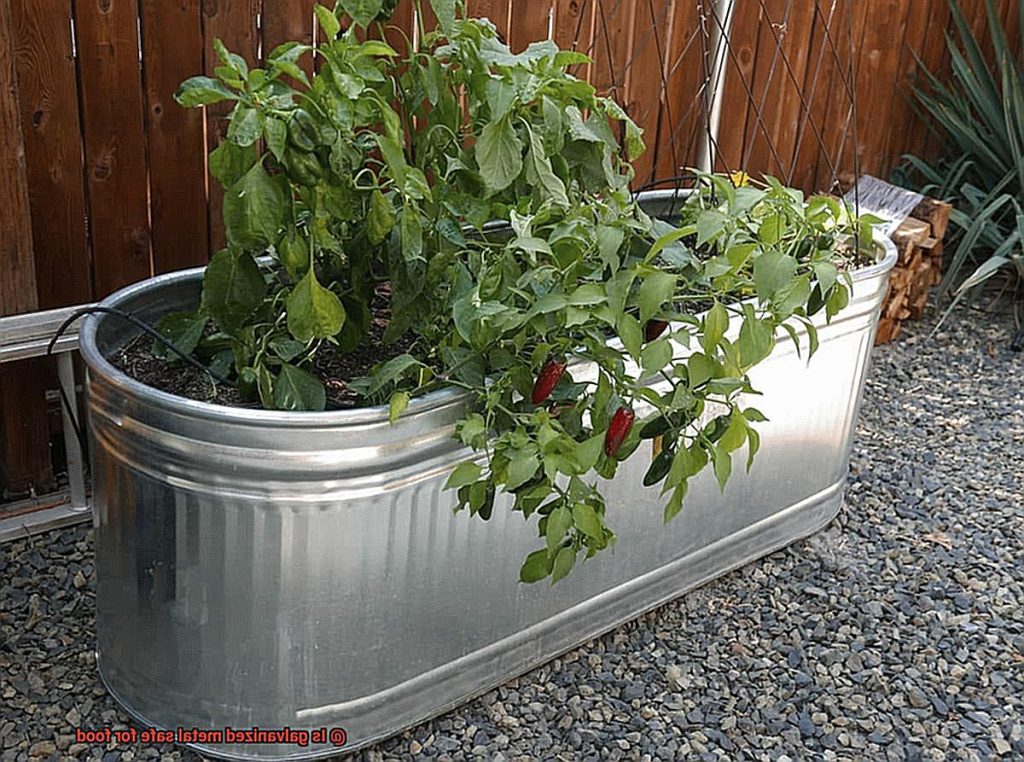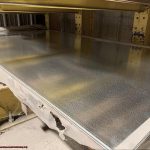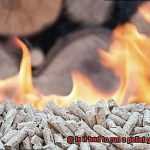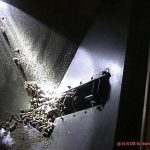Have you ever wondered if the materials used in your kitchen are safe for your health, especially when it comes to food? Well, one material that’s commonly used in food production and storage is galvanized metal. But, is it safe for food? The answer may surprise you.
Galvanized metal is a type of metal coated with zinc to prevent rust and corrosion. It’s often found in everyday items such as countertops, utensils like tongs and spatulas, and even in food storage containers. However, there’s a growing concern about the safety of this material in food-related products.
Why the concern? Zinc is a heavy metal that can pose potential health risks when ingested, especially when it reacts with acidic foods or beverages. So, the question remains: Is galvanized metal safe for food?
In this blog post, we’ll explore the risk factors associated with galvanized metal and its impact on our health. We’ll also provide some best practices for safely using this material when preparing and storing food. Let’s dive in together to find out if galvanized metal is a safe option for our food-related products.
Contents [show]
What is Galvanized Metal?
Galvanized metal is a versatile material that has been coated with a layer of zinc to protect it from rust and corrosion. This process involves immersing the metal in a bath of molten zinc, which creates a chemical reaction that bonds the zinc to the metal surface. The result is a durable and cost-effective choice for outdoor applications, industrial purposes, and even some food-related uses.
Galvanized metal is often used for outdoor applications such as roofing, fencing, and gutters, as well as for industrial purposes such as pipes and machinery. It is also sometimes used in food-related applications such as storage containers, cooking grates, and utensils.
The zinc coating on galvanized metal provides a barrier between the metal surface and the surrounding environment, which helps to prevent rust and corrosion. However, over time, the zinc coating can wear away or become damaged, exposing the underlying metal to moisture and other corrosive elements.
When it comes to food-related applications, there are some concerns about the potential for zinc to leach into food over time. Acidic foods such as tomatoes or citrus fruits can cause the zinc coating to break down more quickly, increasing the risk of zinc leaching into the food. While galvanized metal is generally considered safe for food-related applications, it is important to take precautions to minimize the risk of zinc exposure.
If you do choose to use galvanized metal for cooking or storing food, it is important to take extra precautions. Choose high-quality galvanized metal products and avoid using acidic foods with galvanized containers or cooking surfaces. Regularly inspect and replace any damaged or worn-out galvanized metal items.
It is also worth noting that galvanized metal may contain traces of lead, a highly toxic substance that can cause serious health problems. While the amount of lead found in galvanized metal is typically very low, it is still a concern for those who are particularly sensitive to it.
Potential Health Risks of Galvanized Metal
Galvanized metal is a popular material used in the food industry due to its durability and cost-effectiveness. But were you aware of the potential health risks associated with its use in food preparation and storage?
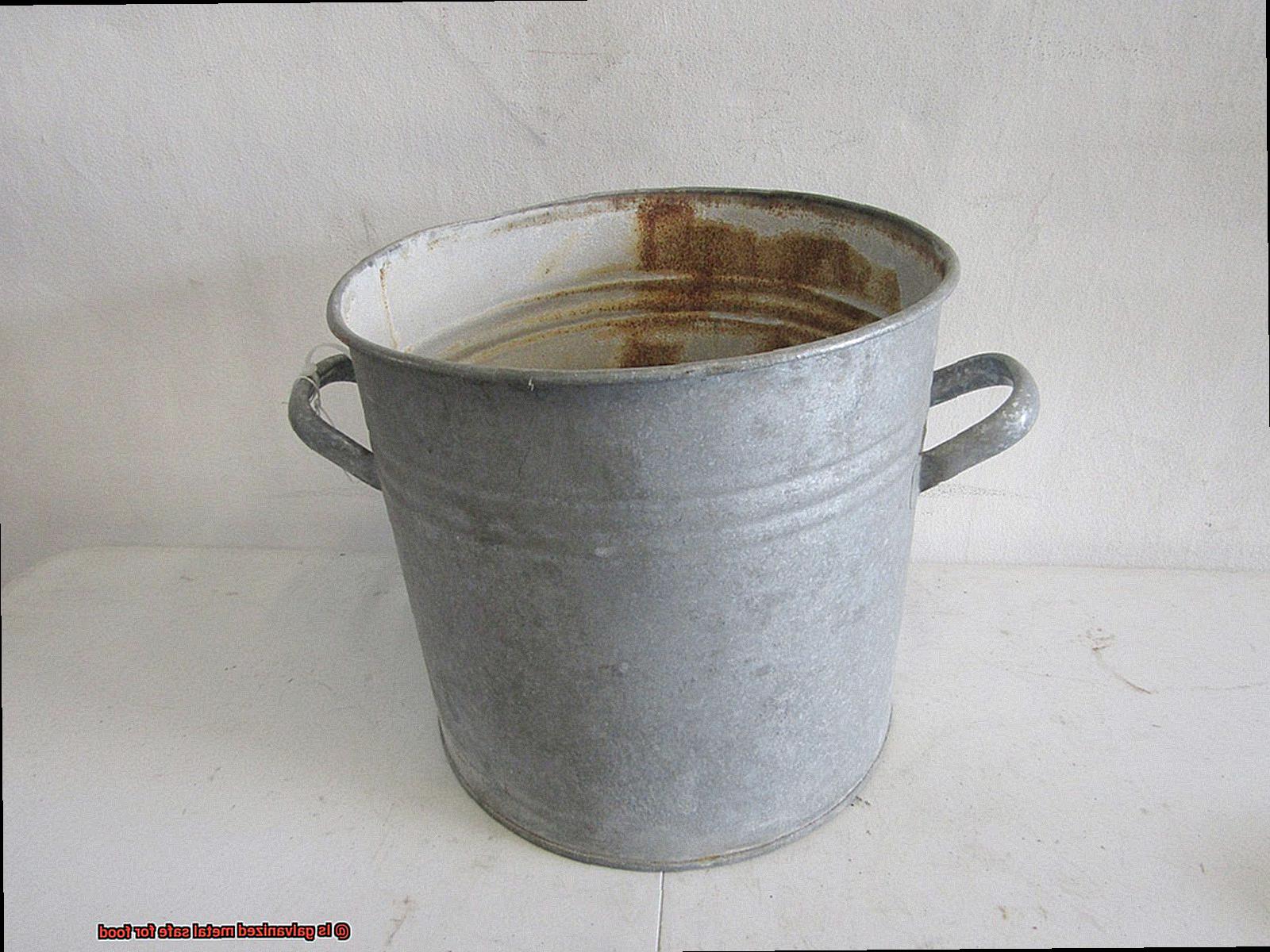
One major concern is the corrosion of the zinc coating on galvanized metal when exposed to acidic foods like tomatoes or citrus fruits. This corrosion can lead to zinc leaching into the food, which can be toxic if ingested in large amounts. It’s alarming that many of us store our food in galvanized metal containers without realizing the potential risk.
But wait, there’s more. Galvanized metal may also contain traces of lead, a highly toxic heavy metal. Lead can seep into food if the coating on the metal has been damaged or exposed to high temperatures. And it’s not just cookware that poses a risk – utensils made from this material can also be problematic.
Furthermore, there are environmental concerns associated with galvanized metal. The production process involves chemicals that can be harmful to both workers and the environment, and it is difficult to recycle. When it ends up in landfills, it can contaminate the soil and water with toxic chemicals.
So what’s the solution? Experts recommend using alternative materials such as stainless steel or ceramic for food preparation and storage. These materials are safer, have less impact on the environment, and are easily recyclable.
Is Galvanized Metal Safe for Food?
Galvanized metal is a type of metal that is coated with zinc to prevent rust and corrosion. It is commonly used in outdoor grills, food storage containers, and even cooking utensils. However, when it comes to using galvanized metal in food-related activities, there are some essential factors to consider.
Firstly, while galvanized metal is generally considered safe for food storage and preparation, it can potentially react with acidic foods such as tomatoes, citrus fruits, or vinegar-based dressings. This reaction can cause the zinc to leach into the food, resulting in a metallic taste and posing a risk if ingested in large amounts.
To avoid this issue, it is best to avoid using galvanized metal containers or utensils with acidic foods. Instead, opt for stainless steel or glass containers for these types of foods.
Secondly, and most importantly, galvanized metal should never be used for cooking food directly. When exposed to high heat, the zinc coating on galvanized metal can break down and release toxic fumes that can be harmful when inhaled. So always remember to use other types of cookware such as stainless steel or cast iron.
In summary, while galvanized metal can be safe for food-related activities, it is crucial to follow some basic guidelines. Avoid using it with acidic foods and never use it for direct cooking. By doing so, you can enjoy your food without putting your health at risk.
Alternatives to Galvanized Metal for Food-Related Purposes
Although galvanized metal is a popular choice for food-related purposes due to its durability and affordability, it can also pose potential health risks. The good news is that there are several alternatives to galvanized metal that are both safe and effective.
First on the list is stainless steel. This corrosion-resistant material not only looks sleek but also does not react with acidic foods, making it a top choice for commercial kitchens. Plus, it is easy to clean and maintain, making it an ideal option for busy households.
Another great alternative is glass. Glass containers are non-reactive and do not absorb odors or flavors from food, ensuring that your meals remain fresh and delicious. Additionally, glass is a durable and easy-to-clean material, which means you can use it over and over again without worrying about any harmful chemicals leaching into your food.
Ceramic cookware is another safe alternative to galvanized metal. It’s non-reactive, meaning it won’t leach any chemicals into your food. Furthermore, ceramic cookware is versatile since it can be used in ovens, microwave ovens, and on stovetops. Plus, it comes in various colors and designs to complement any kitchen décor.
Lastly, certain types of plastic such as polypropylene and high-density polyethylene are safe for food-related purposes. These plastics are non-toxic, dishwasher safe, and do not react with acidic foods. Additionally, they come in a wide range of shapes and sizes, making them perfect for storing leftovers or packing lunches on the go.
How to Minimize Risk When Using Galvanized Metal
Galvanized metal is a durable and affordable material used for household items such as buckets, watering cans, and outdoor grills. However, the zinc coating on galvanized metal can potentially leach into your food, leading to health problems if ingested in large amounts. To minimize this risk when using galvanized metal for food-related purposes, there are several precautions you can take.
Be Mindful of Foods That React with Zinc Coating
The first step to minimizing the risk of zinc leaching is to be aware of foods that react with the zinc coating. Acidic foods such as tomatoes, citrus fruits, and vinegar-based dressings can cause the coating to break down more quickly, leading to higher levels of zinc in your food. Therefore, it’s best to avoid using galvanized metal for these types of foods and instead opt for stainless steel or other non-reactive materials.
Properly Clean and Maintain Your Galvanized Metal Cookware or Utensils
Over time, the zinc coating on galvanized metal can wear down and become more susceptible to leaching. To prevent this, it’s important to avoid using abrasive cleaners or scrubbers that can scratch the surface of the metal. Instead, use mild soap and water and dry thoroughly after each use.
Monitor Cooking Temperatures When Using Galvanized Metal
High heat can cause the zinc coating to break down more quickly, leading to higher levels of zinc in your food. To minimize this risk, it’s best to avoid using galvanized metal for high-heat cooking methods such as grilling or broiling. Stick to lower heat methods such as baking or sautéing instead.
Avoid Long-Term Food Storage in Galvanized Metal Containers
The zinc coating on galvanized metal can break down and corrode over time, increasing the risk of contamination. It’s best to opt for glass or plastic containers for long-term food storage instead of galvanized metal.
Be Cautious if You Are Pregnant or Have a Weakened Immune System
Individuals who are pregnant or have weakened immune systems are at a higher risk of developing complications from exposure to harmful chemicals and metals. It is recommended that these individuals do not use galvanized metal for food-related purposes.
Corrosion and its Effects on the Safety of Galvanized Metals
Corrosion is a natural process that occurs when metals come into contact with moisture, oxygen, and environmental factors. While galvanized metals are coated with layers of zinc to prevent corrosion, over time, this coating can wear down and expose the underlying metal to corrosion.
When it comes to food safety, corrosion can be a serious concern. As the protective layer on galvanized metal wears down, it can release zinc into the food or drink being stored or served in the container. Although small amounts of zinc are essential for human health, excessive amounts can lead to nausea, vomiting, and diarrhea.
Moreover, corrosion can also lead to the release of other harmful substances such as lead or cadmium. These metals are often used in the production of galvanized steel and can pose significant health risks if ingested.
To ensure that your galvanized metal containers are safe for use in food storage or serving, it’s important to regularly inspect them for signs of corrosion. If any signs of wear and tear are present, you should immediately remove the container from service and replace it with a new one.
Here are some tips to help you prevent corrosion and keep your galvanized metal containers safe:
- Avoid exposing them to acidic foods or liquids as they can speed up the corrosion process.
- Properly clean and maintain your cookware or utensils by hand washing and drying them thoroughly after each use.
- Monitor cooking temperatures as overheating can cause damage to the protective coating.
- Avoid long-term food storage in galvanized metal containers as prolonged contact with food can also cause corrosion.
- Consider switching to alternative materials such as stainless steel or glass if you are pregnant or have a weakened immune system.
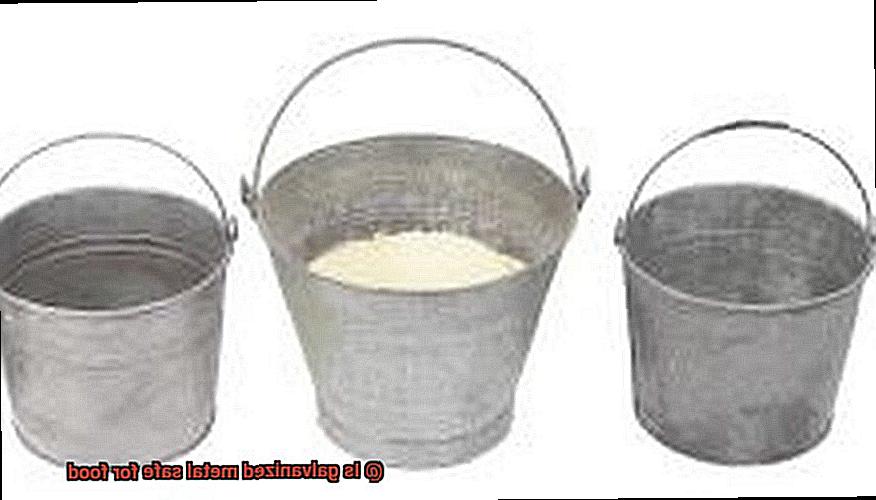
Common Uses of Galvanized Metals in Households
Galvanized metals are a versatile and cost-effective option for many household applications, thanks to their resilience and resistance to corrosion. From roofing and gutters to pipes and even kitchenware, galvanized metals can be found throughout our homes. However, it’s important to be aware of the potential health risks associated with using galvanized metals for food-related purposes.
In the kitchen, galvanized metal is commonly used to make utensils like mixing bowls, colanders, and baking sheets. While these items may not come into direct contact with food, there is still a risk of zinc leaching into the food if the galvanized coating becomes damaged or scratched. Zinc is an essential mineral that our bodies require in small amounts but can be harmful in larger quantities.
To make matters worse, acidic foods such as tomatoes and citrus fruits can cause the zinc coating to react and leach into the food. This not only affects the taste of the food but also poses potential health risks. Therefore, it is crucial to avoid storing acidic foods in galvanized metal containers.
It’s worth noting that not all galvanized metals are created equal. Some may contain higher levels of zinc than others, which can increase the risk of zinc poisoning. To avoid potential health hazards, it’s best to purchase kitchenware made from high-quality stainless steel or other food-grade materials.
In summary, while galvanized metals have many practical uses in households, it’s essential to exercise caution when using them for food-related purposes. Opting for food-grade materials when cooking or storing food can help ensure safety and prevent potential health risks. To that end, here are some common uses of galvanized metals in households:
- Roofing
- Gutters
- Pipes
- Kitchenware (excluding food storage containers)
- Outdoor furniture
- Garden tools
Tips for Proper Cleaning and Maintenance of Galvanized Metals
Galvanized metals are a popular choice for various applications in the food industry. However, failure to maintain and clean them properly can lead to contamination of food. In this regard, the following sub-sections detail why proper cleaning and maintenance of galvanized metals are crucial for use in the food industry.
Cleaning the Metal Surface
The first step in maintaining galvanized metal for food use is to regularly clean it with a mild detergent and warm water. Cleaning helps remove any dirt or debris from its surface that may harbor harmful bacteria. It is crucial to avoid using abrasive cleaners or steel wool as they can scratch the surface of the metal and expose the underlying zinc coating, leading to corrosion and rusting.
Rinsing and Drying the Surface
After cleaning, it is essential to rinse the surface thoroughly with clean water to remove any remaining soap or detergent residue. Any moisture left on the surface can lead to corrosion and rusting of the metal, which can contaminate food. Therefore, it is crucial to dry the surface completely using a clean, dry cloth.
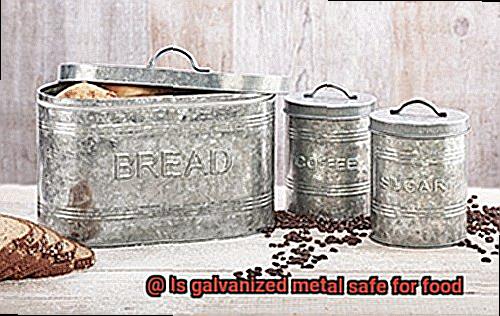
Regular Maintenance
Regular maintenance of galvanized metal is necessary to ensure its longevity and prevent any contamination of food. Applying a protective coating such as a clear lacquer or paint over the zinc coating can help maintain galvanized metal. Protective coatings prevent direct contact between food and the zinc coating, reducing the risk of contamination. It is also essential to inspect galvanized metal regularly for any signs of wear or corrosion and repair any damaged areas immediately.
Avoid Acidic Foods
When using galvanized metal for cooking, it is important to avoid acidic foods such as tomatoes or citrus fruits. Acidic foods can react with the zinc coating and potentially contaminate the food. Instead, opt for non-acidic foods such as meats and vegetables.
Seek Professional Advice
It is crucial always to err on the side of caution and seek professional advice if there are any concerns about the safety of using galvanized metal for food. Professionals can offer guidance on proper cleaning and maintenance procedures.
VDCzMaL0oiY” >
Conclusion
In conclusion, galvanized metal is a popular choice for various household items, including food storage containers, utensils, and cooking grates. However, concerns about its safety in food-related products are on the rise.
Zinc, the coating used to prevent rust and corrosion in galvanized metal, can pose health risks when ingested. Acidic foods or beverages can cause zinc to leach into the food, leading to unpleasant symptoms such as nausea, vomiting, and diarrhea. Additionally, galvanized metal may contain traces of lead which is highly toxic and can cause serious health problems.
To ensure safe use of galvanized metal for food-related purposes, it’s essential to take precautions. Avoid using it with acidic foods and never use it for direct cooking. Regularly inspect and replace any damaged or worn-out galvanized metal items.
Fortunately, several safe alternatives exist for food-related applications. Stainless steel, glass containers, ceramic cookware, and certain types of plastic such as polypropylene and high-density polyethylene are all excellent choices.
Proper cleaning and maintenance of galvanized metals are crucial for their longevity and preventing contamination of food. Applying protective coatings over the zinc coating can help maintain the metal’s integrity while avoiding acidic foods when cooking is essential.
Overall, while galvanized metal can be safe for food-related activities if used correctly, it’s vital to follow some basic guidelines to minimize the risk of zinc exposure.

